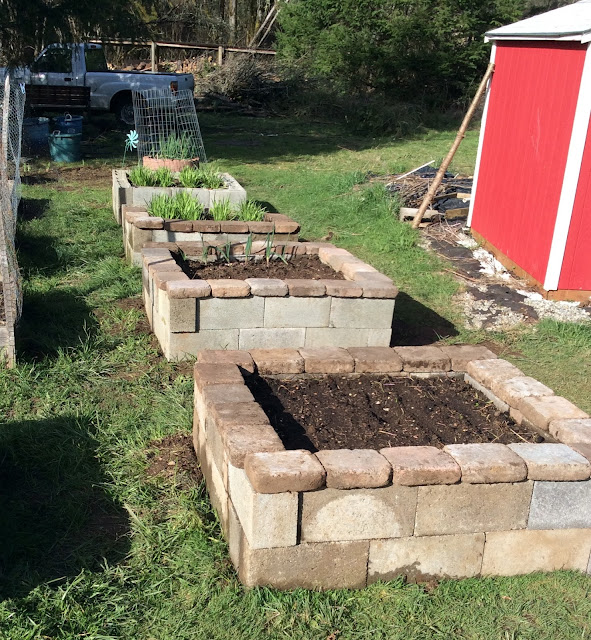I completed the newest raised beds. There are now four. They are build largely from recycled narrow cement blocks from the old place, used there for a variety of purposes. I needed some to complete the last two beds. The blocks are 99 cents each at Home Depot. Each bed requires 21 blocks, plus one half-block and some bricks due to dimensions that don't match because of shape.
All of my raised beds are built on a chicken wire fencing base, to prevent moles from tunneling up into the beds.
Dimensions are roughly 4 feet by 4 feet by 18 inches high.
The capstones are all re-used from a patio. They are cobblestone pavers.
 |
| Recycled Concrete Block Raised Beds. 3.4.16 |
I measured the soil temperatures this week. The base soil was 60F. In the lower, wooden raised beds, the soil was 62F. In the concrete raised beds, the soil was 65F. This time of year, the warmer soil is an advantage. Mulch may be needed later, to reflect heat.
The pavers add a little height. My theory is the concrete blocks absorb heat, even though color is not dark, and transmit that heat to the air spaces. The air is warmed, and the pavers hold the warm air in place. During the summer, pavers could be removed to allow excape of the warm air, if I think that is an issue.
For senior access and gardening comfort / accessibility, these concrete block raised beds seem ideal. They are a good sitting height. The blocks make it possible to sit on the edge of the bed and work soil with hand tools. They are nearer to visual comfort height, which makes planting seeds and weeding easier.
I planted seeds from old packets, radishes, scorzina, spring greens. One bed has some overflow scallions, perennial onions. I want to grow flowers in one bed when / if the spring vegetables and greens are finished.
I also have smaller raised beds - these fall between raised bed and container. They are made from re-used concrete tree rings, stacked to fit together.
In this case, the container / bed contains hyacinths - planted deep - and daylilies, planted above the hyacinths. I have grown other plants in this system - potatoes, perennial onions, annuals. The height and size is very convenient. There is no bottom, but I lay down a base of chicken wire fencing to prevent mole infestation and disruption.